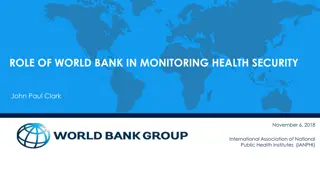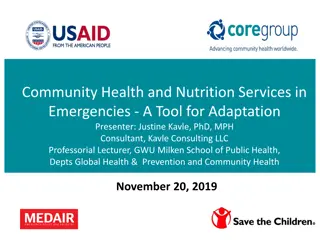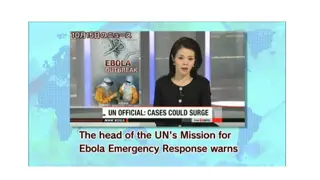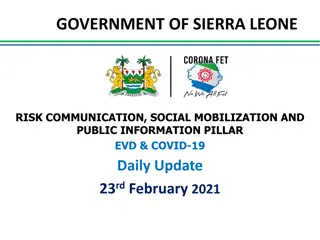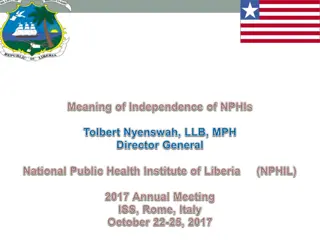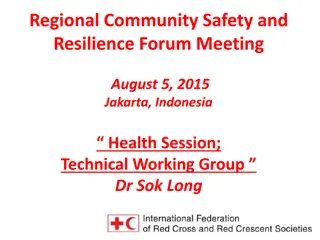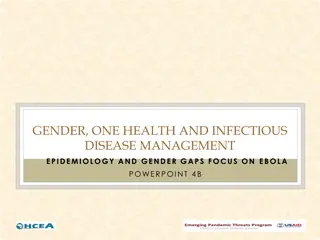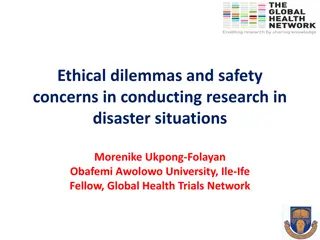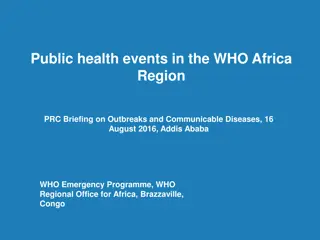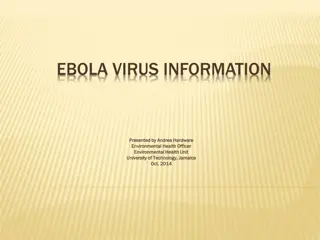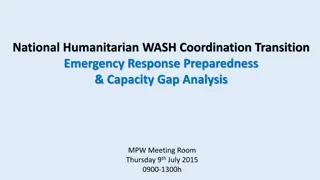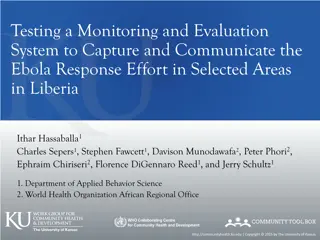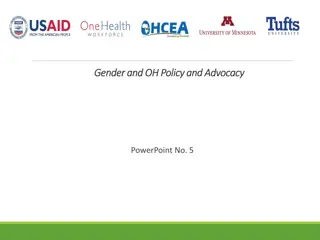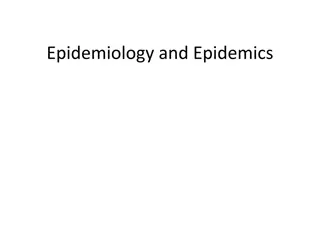
Understanding Ebola Virus: Overview, Prevention, and Role of Community Health Nurses
Learn about the Ebola virus, its epidemiology, high-risk groups, transmission, prevention methods, signs, symptoms, complications, diagnosis, vaccine development, treatment, and the crucial role of community health nurses in managing Ebola disease effectively.
Download Presentation

Please find below an Image/Link to download the presentation.
The content on the website is provided AS IS for your information and personal use only. It may not be sold, licensed, or shared on other websites without obtaining consent from the author. If you encounter any issues during the download, it is possible that the publisher has removed the file from their server.
You are allowed to download the files provided on this website for personal or commercial use, subject to the condition that they are used lawfully. All files are the property of their respective owners.
The content on the website is provided AS IS for your information and personal use only. It may not be sold, licensed, or shared on other websites without obtaining consent from the author.
E N D
Presentation Transcript
1- Objective 2- Overview of Ebola virus 3- Epidemiology 4- High risk group 5- Transmission 6- Prevention 7- Signs and symptoms 8- Complication 9- Diagnosis 10- Vaccine development and treatment 11- Role of community health nurses 12- Summary 13- Conclusion 14- article 15- References
At the end of this seminar the students will be able to : * 1- Identify the Ebola virus within 2 minute . *2- identify the high risk group within 5 minute. *3- Mention 3 ways of transmission within 2 minute . *4- Recognize 3 ways of prevention within 5 minute. *5- Mention 5 of signs and symptoms within 2 minute. *6- Mention 3 of complication within 2 minute. *7- Recognize the role of community health nurse within 5 minute . *8- Recognize how to manage Ebola disease within 5 minute *9- recognize how diagnose Ebola disease within 5 minute
* - Ebola, previously known as Ebola hemorrhagic fever, is a rare and deadly disease *- Ebola is caused by infection with a virus of the family Filoviridae *- There are five identified Ebola virus species, four of which are known to cause disease in humans and one for none human . *- Ebola can cause disease in humans and nonhuman primates (monkeys, gorillas, and chimpanzees).
*- Ebola viruses are found in several African countries. *- Ebola was first discovered in 1976 near the Ebola River in what is now the Democratic Republic of the Congo. Since then, outbreaks have appeared sporadically in Africa. *-The natural reservoir host of Ebola virus remains unknown. However, on the basis of evidence and the nature of similar viruses, researchers believe that the virus is animal-borne and that bats are the most likely reservoir. Four of the five virus strains occur in an animal host native to Africa.
*-Healthcare providers who caring for Ebola patients and family and friends in close contact with Ebola patients are at the highest risk of getting sick because they may come in contact with infected blood or body fluids .
1) direct contact (through broken skin or mucous membranes for example, the eyes, nose, or mouth) . 2)blood or body fluids ( urine, saliva, sweat, feces, vomit, breast milk, and semen) of a person who is sick with or has died from Ebola. 3) objects (like needles and syringes) that have been contaminated with body fluids from a person who is sick with Ebola or the body of a person who has died from Ebola.
4) infected animal such as : fruit bats or primates (apes and monkeys), 5) possibly from contact with semen from a man who has recovered from Ebola (for example, by having oral, vaginal, or anal sex For example, in Africa, Ebola may spread as a result of handling bush meat (wild animals hunted for food) and contact with infected bats
If you travel to or are in an area affected by an Ebola outbreak, make sure to do the following: 1) Practice careful hygiene. 2) Do not handle items that may have come in contact with an infected person s blood or body fluids 3) Avoid funeral or burial rituals that require handling the body of someone who has died from Ebola.
4) Avoid contact with bats and nonhuman primates or blood, fluids, and raw meat prepared from these animals. 5) Avoid facilities in West Africa where Ebola patients are being treated. 6) Avoid contact with semen from a man who has had Ebola until you know Ebola is gone from his semen.
Healthcare workers who may be exposed to people with Ebola should follow these steps: 1) Wear appropriate personal protective equipment (PPE). 2)Practice proper infection control and sterilization measures. 3) Isolate patients with Ebola from other patients. 4) Avoid direct, unprotected contact with the bodies of people who have died from Ebola.
Fever Severe headache Muscle pain Weakness Fatigue Diarrhea Vomiting Abdominal (stomach) pain Unexplained hemorrhage (bleeding or bruising)
Ebola infection lead to death for a high percentage of people who are affected. As the illness progresses, it can cause: Multiple organ failure Severe bleeding Jaundice Delirium Seizures Coma Shock
Diagnosing Ebola in a person who has been infected for only a few days is difficult because the early symptoms, such as fever, are nonspecific to Ebola infection and often are seen in patients with more common diseases, such as malaria and typhoid fever. However, a person should be isolated and public health authorities notified if they have the early symptoms of Ebola and have had contact with blood or body fluids from or object contaminated with a person sick or died from Ebola .
Samples from the patient can then be collected and tested to confirm infection. Ebola virus is detected in blood only after onset of symptoms, most notably fever, which accompany the rise in circulating virus within the patient's body. It may take up to three days after symptoms start for the virus to reach detectable levels. *Laboratory tests used in diagnosis include 1- IgM ELISA 2- Polymerase chain reaction (PCR) 3- Virus isolation
*- There is no vaccine or medicine (e.g., antiviral drug) available for Ebola. *- Experimental vaccines and treatments for Ebola are under development, but they have not yet been fully tested for safety or effectiveness.
Symptoms of Ebola and complications are treated as they appear. *- The following basic interventions, when used early, can significantly improve the chances of survival: *1- Providing intravenous fluids (IV) and balancing electrolytes (body salts). *2- Maintaining oxygen status and blood pressure. *3- Treating other infections if they occur.
Recovery from Ebola depends on good supportive care ; and the People who recover from Ebola infection develop antibodies that last for at least 10 years, possibly longer. It is not known if people who recover are immune for life or if they can become infected with a different species of Ebola. Some people who have recovered from Ebola have developed long-term complications, such as joint and vision problems.
As educator Perform health education about how to protect your self from Ebola virus .. ( target group ( the high risk group ) educate them the transmission route and the early sign and symptom of the disease to increase survival chance . As researcher Collect data about Ebola virus prevalence rate , survival rate , epidemiology , ETC..
As clinician provide services that are essential to or helpful in the promotion, maintenance, and restoration of health and well-being especially for Ebola virus patient and the risky group . As counselor The nurse must be available for any extra question from patients or them families or from the community about Ebola virus As advocator Advocate about patient right to have the cure.
*- Ebola is caused by infection with a virus of the family Filoviridae *- Ebola viruses are found in several African countries. *-Healthcare providers who caring for Ebola patients and family and friends in close contact with Ebola patients are at the highest risk of getting sick from Ebola virus . Fever , Severe headache , Muscle pain , Weakness are the early S&S for Ebola. *- There is no vaccine or medicine for Ebola virus . community Nursing role with this disease being as ( educator , counselor , clinician , researcher , and advocator ).
Ebola virus, a member of the Filoviridae virus family, is still an untamed, highly lethal viral pathogen that represents a nightmare for much of central Africa, which is the site of the majority of EBOV outbreaks (Geisbert et al.2010).
Effects of Mother's Illness and Breastfeeding on Risk of Ebola Virus Disease in a Cohort of Very Young Children.
^ Jump up to: a b cRuzek, edited by Sunit K. Singh, Daniel (2014). Viral hemorrhagic fevers. Boca Raton: CRC Press, Taylor & Francis Group. p. 444. ISBN 9781439884294. ^ Jump up to: a b"2014 Ebola Virus Disease (EVD) outbreak in West Africa". WHO. 21 April 2014. Retrieved 3 August 2014. ^ Jump up to: a b c d"Preliminary study finds that Ebola virus fragments can persist in the semen of some survivors for at least nine months". CDC. 14 October 2015.



